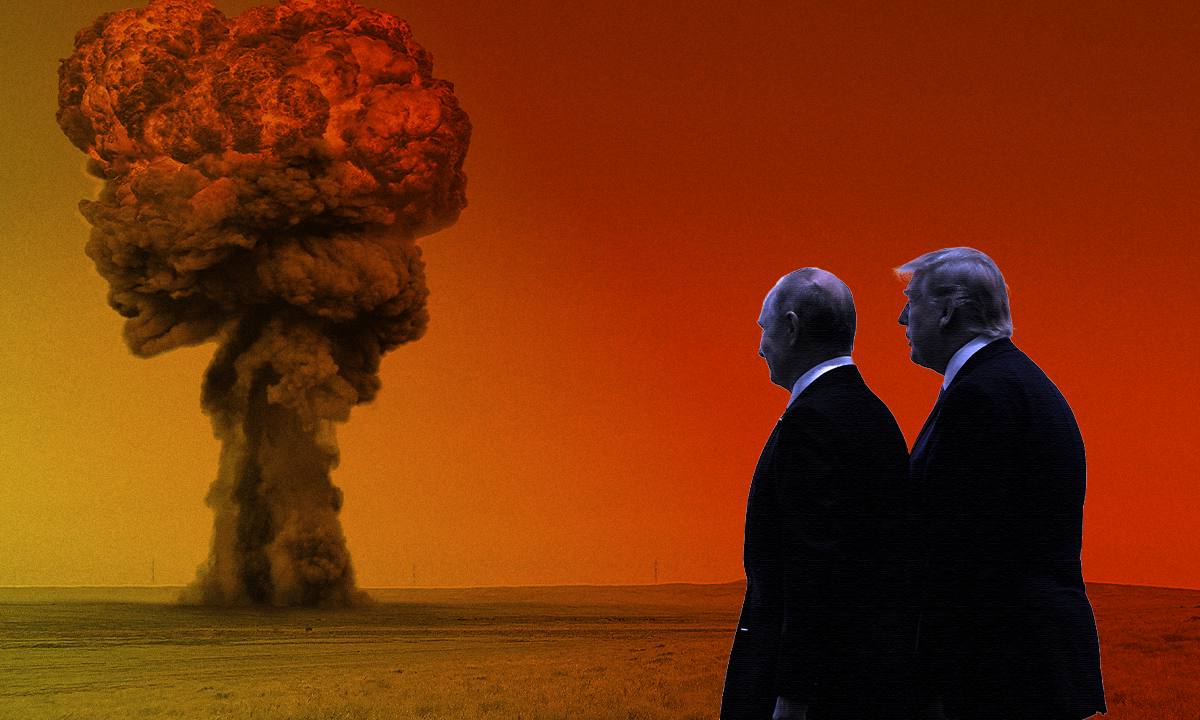Beyond the Button
If Donald Trump is going to leave a Nixon-Goes-to-China legacy for the world, let it be in the realm of nuclear sanity. (Graphic by Truthdig. Images via AP Photo and Adobe Stock)
(Graphic by Truthdig. Images via AP Photo and Adobe Stock)
It is the most curious chapter of Donald Trump’s political life: In the mid-1980s, at the nadir of the late Cold War, the Republican playboy of Manhattan real estate emerged as a brash voice for nuclear disarmament. Trump made his first public remarks on the issue in 1984, during the Reagan administration’s aggressive “full-court press” against the Soviet Union, a terrifying chapter of the superpower standoff marked by chest-bumping missile deployments and an out-of-control arms race. A couple of years later, calls for arms reduction and disarmament would become mainstream and “safe.” But Trump’s public views preceded the post-1986 thaw, putting him squarely on the side of an abolition movement led by left-wing parties and groups. The timeline of Trump the Disarmament Activist was first described in 2017 in the Hollywood Reporter:
In an April 8, 1984, profile in the New York Times, Trump revealed that concern about a nuclear holocaust had plagued him since his uncle, the groundbreaking nuclear physicist John Trump, first spoke to him about it 15 years earlier. “His greatest dream is to personally do something about the problem,” wrote the Times’ William E. Geist (NBC anchor Willie Geist‘s father), “and, characteristically, Donald Trump thinks he has an answer to nuclear armament: Let him negotiate arms agreements — he who can talk people into selling $100 million properties to him for $13 million.” … Though the lengths to which Trump went to learn about Gorbachev and to secure an official post from the Americans never have been revealed, Trump’s interest in “making a deal” with the Soviets was widely reported — and mocked — at the time.
The possibility that Trump may have stood atop the newly completed Trump Tower in July 1982 and admired the million protestors who marched through Central Park demanding a nuclear freeze is a strange one. As Trump prepares to retake control of the country’s nuclear arsenal and strategy at a time of historic nuclear danger, it is also a desperately comforting one. Compared to the cabinet of hawks he will be bringing with him, his unlikely history in this area provides a measure of hope that the commander in chief retains something of the nuclear realism and revulsion of his younger self.
Trump’s nuclear activism, such as it was, was never selfless — he did not spend weekends stuffing pamphlets and maps of blast zones in doorways and mail boxes — but typically self-aggrandizing. During his years petitioning the Reagan administration to make him “a plenipotentiary ambassador,” he imagined himself as the Great Negotiator at the center of an historic deal with the Soviet Union. As president, he now has ultimate authority to negotiate nuclear policy and agreements. Even if the moment does not lend itself to grand deals, there is growing recognition that the decisions made during the next four years may go far in deciding our nuclear fate.
Trump will arrive in office at the hinge point of a dawning “third nuclear age.” If allowed to develop along its current trajectories, it is universally agreed that this age will be far more dangerous than the one that preceded it. It is defined by an increased reliance on tactical nuclear weapons, lower thresholds for use, the addition of a new nuclear great power (China) and a three-way arms race amid multiplying proliferation threats. As arms control expert Geoff Wilson explains in Arms Control Today, the U.S. role in hastening this new age has been far from just reactive. Washington, he writes,
has led the charge in this new nuclear arms race, dedicating $1.7 trillion to its nuclear arsenal over the next 30 years, or roughly $75 billion a year between fiscal years 2023 and 2032. … The development of new and more usable nonstrategic nuclear weapons such as the W76-2 warhead, which is deployed on Navy submarines, and the nuclear-armed submarine-launched cruise missile, which is still under development, signaled that the United States might turn away from Reagan’s declaration that “a nuclear war cannot be won and must never be fought” and instead could see a use for a “limited” nuclear strike and war-fighting strategy. As a result, there is real cause for concern that the United States will continue to commit itself to an expanded role for nuclear weapons in its military and foreign policy. Congressional leaders, military commanders and former Trump administration officials are campaigning for new nuclear weapons and funding above the current $1.7 trillion nuclear modernization program.
The slowing, stopping or reversing of these trends would amount to a partial realization of Trump’s Cold War dream of eradicating the nuclear scourge entirely. “If Mr. Trump is serious about truly making America great again,” argued the New York Times editorial board in a recent multimedia essay, “The President’s Arsenal,” the nuclear threat is “one critical issue where he can make his mark.”
It can’t be ignored that in his first term, Mr. Trump played a significant role in fostering at least some of the risk the world now faces. Yet, given the changed landscape, the United States will have no choice but to lead — something that, based on his campaign rhetoric, Mr. Trump appears to embrace. … In 1986, when he was still principally a New York real estate developer, Mr. Trump reached out to the International Physicians for the Prevention of Nuclear War, which had just received a Nobel Peace Prize for its disarmament work. He hoped to arrange negotiations with the Soviets to lower the nuclear threat. … Now it will be the job of President Trump to pull the world back from the brink. It’s time to discuss what he and the United States should prioritize.
The paper proposes a five-point program that includes restarting the arms control process with Russia; maintaining the ban on explosive testing; reviewing nuclear spending; and changing the chain of command so that Congressional approval is required before launching nuclear weapons. This is a conservative list — it does not even suggest eliminating the current policy of “launch on warning” — but perhaps it is all that can be hoped for in the current context.
If the public is not engaged in this agenda, it’s no surprise. The details of nuclear policy, negotiations, and doctrine get eye-glazingly weedy faster than an ICBM can destroy a city, and public engagement has always required a gut sense for the horrors and costs of nuclear war. That visceral understanding has evaporated since the 1990s. To try and reverse this, last month 144 U.N. member states approved a major study of the effects of nuclear war — the first such report since a similar initiative in the 1980s introduced the world to the concept of nuclear winter. This time around, China was the only nuclear state to vote in favor of the resolution; Russia, France, the U.K. and the U.S. abstained. As François Diaz-Maurin writes in the Bulletin of Atomic Scientists,
The new U.N. study will examine “the physical effects and societal consequences of a nuclear war on a local, regional and planetary scale, including, inter alia, the climatic, environmental and radiological effects, and their impacts on public health, global socioeconomic systems, agriculture and ecosystems, in the days, weeks and decades following a nuclear war.” For Alan Robock, a climatologist at Rutgers University and a leading scientist in the study of the impacts of nuclear war who helped develop the science of nuclear winter since the 1980s, “this will be the most comprehensive study ever on this subject.” … Robock sees the study as a strategic effort toward the complete elimination of nuclear weapons worldwide. “The U.N. report will be important to inform the world of the potential catastrophic impacts of a nuclear war, which could kill most of the people on the planet due to famine from the environmental impacts on agriculture,” he explains. “This report will speed up the adoption of [the U.N. Treaty on the Prohibition of Nuclear Weapons] by the nations that have still not signed and ratified it.”
At the moment, that seems like a distant prospect, at best. But arms control has always been a game of inches and yards — of pushing to add as much space between us and the brink as possible. The brink itself, as the late, great Jonathan Schell reminded us so eloquently, will always be in view, because nuclear knowledge will always be with us. This was easier to convey, at both visceral and intellectual levels, during the 1970s and ’80s, when Trump engaged his quixotic plan to negotiate a big, beautiful deal that would erase nuclear weapons from the face of the earth. Back then, attention spans were longer, distractions were fewer and public opinion could be more easily impacted through traditional media channels. Between the 1940s and 1980s, radio and television were awash in sobering and substantive news and graphic imaginings related to a possible global nuclear war.
Among the Western networks, the BBC was especially effective in raising consciousness and inspiring activism, including the original Campaign for Nuclear Disarmament, whose symbol became the universal sign for “peace.” Around the time Trump made his first public comments about disarmament, in 1984, the BBC aired documentaries about nuclear winter, such as “On the Eighth Day,” as well as the nuclear docudrama masterpiece, “Threads.” The latter, which aired on BBC2, remains the strongest medicine available against nuclear forgetting, and would make a fine selection for the inaugural White House movie screening hosted by the incoming First Family — even if, as is likely, the president has seen it before.
Your support is crucial...As we navigate an uncertain 2025, with a new administration questioning press freedoms, the risks are clear: our ability to report freely is under threat.
Your tax-deductible donation enables us to dig deeper, delivering fearless investigative reporting and analysis that exposes the reality beneath the headlines — without compromise.
Now is the time to take action. Stand with our courageous journalists. Donate today to protect a free press, uphold democracy and uncover the stories that need to be told.






You need to be a supporter to comment.
There are currently no responses to this article.
Be the first to respond.